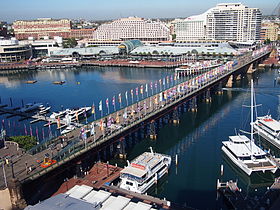Pyrmont Bridge | |
|---|---|
 Pyrmont Bridge in 2014. | |
| Coordinates | 33°52′14″S 151°12′02″E / 33.870575°S 151.200667°E |
| Carries | Pedestrian and bicycle traffic |
| Crosses | Cockle Bay |
| Locale | Darling Harbour, Sydney, New South Wales, Australia |
| Owner | Sydney Harbour Foreshore Authority |
| Maintained by | Sydney Harbour Foreshore Authority |
| Heritage status |
|
| Preceded by | Pyrmont Bridge (1858–1902) |
| Followed by | Western Distributor (1981–present) |
| Characteristics | |
| Design | Swing bridge |
| Material | Ironbark timber; Steel central spans |
| Total length | 369 metres (1,211 ft) |
| No. of spans | 14 |
| Clearance above | 6.5 metres (21 ft) |
| History | |
| Engineering design by | Percy Allan |
| Construction start | 6 December 1899 |
| Construction cost | £112,569 |
| Opened | 28 June 1902 |
| Statistics | |
| Daily traffic | ~14,000 pedestrians |
| Official name | Pyrmont Bridge |
| Type | State heritage (built) |
| Designated | 28 June 2002 |
| Reference no. | 1618 |
| Type | Road Bridge |
| Category | Transport - Land |
| Location | |
 | |
| References | |
| [1][2][3] | |
The Pyrmont Bridge, a heritage-listed swing bridge across Cockle Bay, is located in Darling Harbour, part of Port Jackson, west of the central business district in the City of Sydney local government area of New South Wales, Australia. Opened in 1902, the bridge initially carried motor vehicle traffic via the Pyrmont Bridge Road between the central business district and Pyrmont. Since 1981 the bridge has carried pedestrian and bicycle traffic only, as motor vehicles were diverted to adjacent freeway overpasses. The bridge was added to the New South Wales State Heritage Register on 28 June 2002, the centenary of its opening.[1]
The Jimmy Barnes' 1985 song "I'd die to be with you Tonight" was filmed on the Bridge, with it in the swing-out configuration. (See:I'd Die to be with You Tonight)
- ^ a b "Pyrmont Bridge". New South Wales State Heritage Register. Department of Planning & Environment. H01618. Retrieved 14 October 2018.
 Text is licensed by State of New South Wales (Department of Planning and Environment) under CC-BY 4.0 licence.
Text is licensed by State of New South Wales (Department of Planning and Environment) under CC-BY 4.0 licence.
- ^ Cite error: The named reference
eawas invoked but never defined (see the help page). - ^ "Pyrmont Bridge: A symbol of Australia's industrial history". Sydney Harbour Foreshore Authority. Government of New South Wales. Retrieved 14 January 2015.